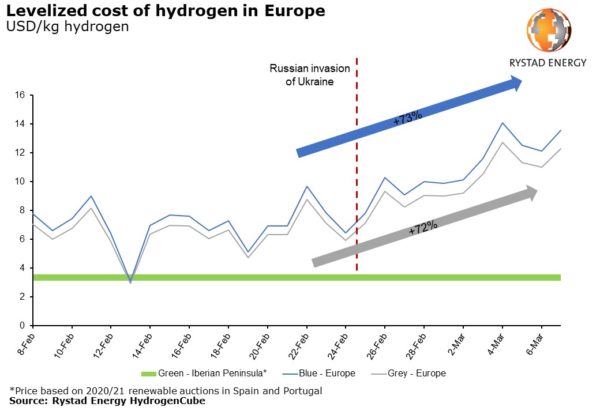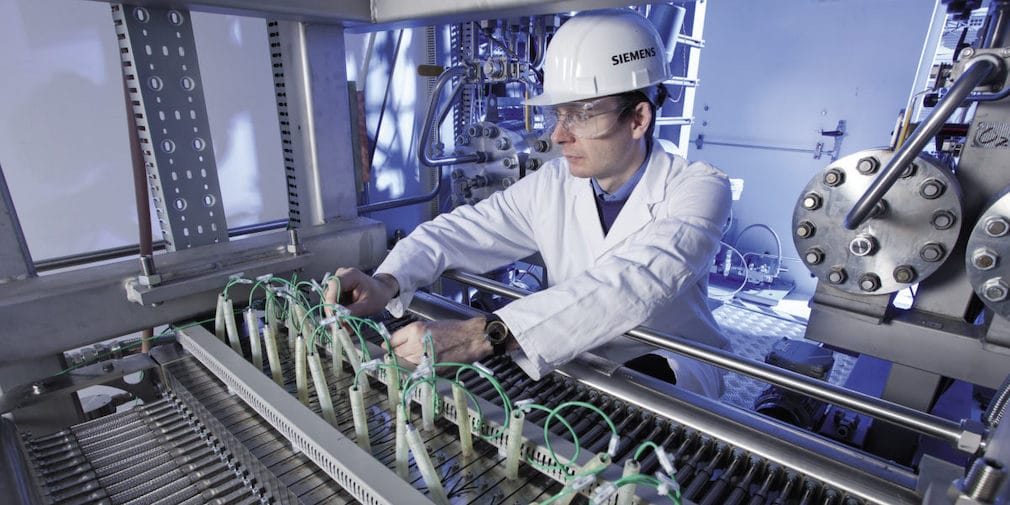From pv magazine global
Russia’s invasion of Ukraine is having widespread geopolitical and economic impacts, not the least of which can be seen in the price spike of gas-powered grey hydrogen and ammonia compared to green versions of the fuels.
Earlier this month, BloombergNEF published a report suggesting “a delivered hydrogen price of $6.59/kg is now sufficient to make green ammonia cheaper than ‘gray’ ammonia, made from unabated natural gas on a short-run, marginal cost basis. This is just enough for a green ammonia facility in Germany to be competitive.” Of course, Bloomberg pointed out that prices in countries like Spain, India and China would be even more competitive.
This week, Rystad Energy similarly predicted that a surging cost of blue and gray hydrogen in line with fossil fuel hikes increased the growing feasibility “of green hydrogen as an affordable and secure source of renewable energy in Europe”.

According to Rystad, the war in Ukraine has “turbocharged” the green hydrogen production sector, which was already set to experience a boom year as it passed the 1GW milestone. Thanks to a 70% increase, Rystad predicts the cost of fossil fuel-linked blue and gray hydrogen could reach from $8/kg to $14/kg “in a matter of days”. For green hydrogen, however, since the invasion of Ukraine Rystad is predicting lower production costs of $4/kg, particularly in Spain, which looking to produce more than 4GW of green hydrogen by 2030.
The market is well and truly swinging, and to add weight to that swing the EU has already announced plans for a €300 million funding package for hydrogen, as well as REPowerEU’s Hydrogen Accelerator initiative to unhook the region from its dependence on Russian gas.
Rystad Energy’s head of hydrogen research Minh Khoi Le said “While industry and governments are heading in the right direction, their challenge is to lower the risks for green hydrogen investors and create incentives necessary to scale up quickly both the demand and supply. Fundamentally, a world where green hydrogen fulfills the role currently played by oil, gas and coal will look very different,” Le continued.
To realize that world green hydrogen production needs to increase to more than 10 million tons worldwide by 2030 and see its costs cut to at least $1.5/kg. 10 million tons might sound like a lot, but according to Rystad if green hydrogen and its derivatives were to replace gas and coal in Europe’s power mix base case by 2030 it would need 54 million tons.
Currently, Europe is working to produce 3 million tons of green hydrogen annually by 2030, while RePower Europe has set a target of 15 million tons per annum. Clearly, there remains an enormous gap, but the effects of Russia’s invasion of Ukraine may just have swung the economics in green hydrogen’s favor.
This content is protected by copyright and may not be reused. If you want to cooperate with us and would like to reuse some of our content, please contact: editors@pv-magazine.com.









By submitting this form you agree to pv magazine using your data for the purposes of publishing your comment.
Your personal data will only be disclosed or otherwise transmitted to third parties for the purposes of spam filtering or if this is necessary for technical maintenance of the website. Any other transfer to third parties will not take place unless this is justified on the basis of applicable data protection regulations or if pv magazine is legally obliged to do so.
You may revoke this consent at any time with effect for the future, in which case your personal data will be deleted immediately. Otherwise, your data will be deleted if pv magazine has processed your request or the purpose of data storage is fulfilled.
Further information on data privacy can be found in our Data Protection Policy.